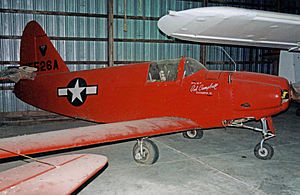- Culver PQ-14 Cadet
-
PQ-14 Culver PQ-14B at the Airpower Museum, Blakesburg, Iowa in 2006 Role Target drone Manufacturer Culver Aircraft Company Designer Albert Mooney Introduction 1942 Retired 1950 Primary users U.S. Army Air Corps
United States Navy
U.S. Army Air Force
United States Air ForceNumber built 2,043 Developed from Culver PQ-8 In 1940, the U.S. Army Air Corps drew up a requirement for a radio-controlled target drone for training anti-aircraft artillery gunners. The first aircraft in a series of target drones was a modification of the Culver LFA Cadet which eventually led to the PQ-14 series used throughout World War II and beyond.
Contents
Design and development
Culver proposed a modification of its civilian Model LFA Cadet which the Army purchased as the PQ-8. The success of the PQ-8 led to the development of the "NRD"; a single PQ-8 was converted to the new configuration and tested by the USAAF as the XPQ-14. Larger and faster than the PQ-8, the PQ-14 also had retractable landing gear and fuselage, wings and tail components made of wood with stressed plywood skin.
This prototype was followed by YPQ-14A service test aircraft and 1,348 PQ-14A production models. Of the latter, 1,198 were transferred to the US Navy, which designated them as TD2C-1 with the decidedly unattractive name Turkey.
The YPQ-14B was a slightly heavier variant; a total of 25 were produced before production shifted to the PQ-14B. A total of 594 PQ-14Bs served as target drones for the USAAF. A single PQ-14B was converted to use an O-300-9 engine and designated XPQ-14C. After World War II, the Culver company developed the XPQ-15 from their Model V light aircraft. After only four were delivered the company went bankrupt in 1946.
Operational history
The XPQ-14 was first flown in 1942 and began to be received in training units shortly after. The aircraft was flown unmanned, controlled by radio, but was flown by a pilot for ferry flights, utililizing a rudimentary control panel installed for that purpose and using their parachutes as a seat. Docile and easy to fly, the aircraft was finished in a bright red target color scheme although operationally, a silver or red finish was applied. Without a pilot they were flown from a "mother ship" aircraft. The typical mother ship was a Beech C-45. Despite their short lifespan, the aircraft performed well and the Franklin engine was considered "trouble-free" [1].
Most of the Culver target aircraft were "blasted out of the sky" by Army anti-aircraft gunners but a dozen or more survived and were surplused after 1950. Flown as a recreational aircraft, their new owners found that the aircraft had a sprightly performance. One is preserved as a flying example at the Planes of Fame in Chino, California[1], another is part of the collection at the National Museum of the United States Air Force and a third is displayed at the Airpower Museum at Blakesburg, Iowa.
Specifications (Culver PQ-14A)
Data from [2]
General characteristics
- Crew: One
- Length: 19 ft 6 in (5.94 m)
- Wingspan: 30 ft (9.14 m)
- Height: 8 ft 4.5 in (2.55 m)
- Loaded weight: 1,830 lb (830 kg)
- Powerplant: 1 × Franklin O-300-11 Single blade, 150 hp (97 kW)
Performance
- Maximum speed: 185 mph (300 km/h)
- Cruise speed: 150 mh (241 km/h)
- Range: 512 mi (823 km)
- Service ceiling: 17,000 ft (5,184 m)
References
- Mondey, David. American Aircraft of World War II (Hamlyn Concise Guide). London: Bounty Books, 2006. ISBN 978-0-7537-1461-4.
- Mormillo, Frank B. "Defenceless Warrior: Culver's PQ-14 Drone." Air Enthusiast Issue 93, May/June 2001.
External links
See also
- Related development
- Aircraft of comparable role, configuration and era
USAF drone aircraft designations 1948–1962 USAAF drone aircraft Controllable bombs Target control aircraft Aerial target (subscale) Aerial target (full-scale) USN target drone aircraft pre-1945 Culver Radioplane TDD • TD4D
Douglas TD2D
Frankfort TD3D
Bell Naval Aircraft Factory Interstate TDR • TD2R • TD3R
Lists relating to aviation General Aircraft (manufacturers) · Aircraft engines (manufacturers) · Airlines (defunct) · Airports · Civil authorities · Museums · Registration prefixes · Rotorcraft (manufacturers) · TimelineMilitary Accidents/incidents Records Categories:- Target drones
- United States civil utility aircraft 1940–1949
- Culver aircraft
- United States military utility aircraft 1940–1949
- Single-engine aircraft
Wikimedia Foundation. 2010.

